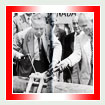|
Page 1 |
2 |
3 |
4 |
5 |
6 |
7 |
8

Imperial had selected a route to a U.S. port at the head of Lake Superior rather than a route to Fort William or Port Arthur on the Canadian side for two reasons: The U.S. route was 120 miles shorter and less costly, and would provide greater access to possible future oil deliveries to Chicago refineries. The shorter route offered a saving of $10 million in construction costs and $1 million per year in operating costs.
Decision to extend the line presented some further engineering problems. Greater deliverability capacity would be required, and this could be more economically provided with a larger-diameter pipeline.
But the 16-inch pipe had already been ordered, and had to be used somewhere. Greatest deliverability capacity would be required on the section from Edmonton to Regina, where the line would make its initial deliveries to refineries. The system ultimately designed by IPL engineers was for a line consisting of 450 miles of 20-inch-diameter pipe from Edmonton to Regina, 340 miles of 16-inch pipe from Regina to Gretna, and 360 miles of IS-inch pipe from Gretna to Superior. Because the Page-Hersey mill was designed to make up to only 16-inch pipe, the 1S- and 20-inch pipe was supplied by U.S. mills. "Because of steel shortages and because further crude reserves were established during the early planning stage," IPL later explained, "the system has 16-inch pipe between sections of 20-inch and IS-inch. This may seem incongruous but it works, and works well.”7
Cost of the system was estimated at nearly $90 million. Giant-sized steel storage tanks, capable of holding more than 1.5 million barrels of oil, would be built at Superior to store oil delivered by the line during the five months of the year that Lake Superior is closed to shipping. Orders were placed with shipyards at Port Arthur and Collingwood, Ontario for two, 15,SOO-ton tankers costing nearly $S million, at that time the world's largest lake tankers.
Estimated cost of moving oil from Edmonton to the major Ontario refiIlery centre at Sarnia was about $1.00 per barrel, a saving of at least $2.50 on the cost by railway.
On September 12, just three months after it had received authority to build its pipeline from Edmonton to Regina, Interprovincial obtained the approval of the Board of Transport Commissioners to extend the proposed system 340 miles to the U.S. border, with its U.S. subsidiary to construct the remaining 360 miles to Superior.
However economically sound it may have been, the decision to terminate the IPL line at Superior rather than at the twin cities of Port Arthur and Fort William in Ontario raised a political storm of protest.
When the first session of the 21st Parliament of Canada assembled that fall, it was not long before the question of the Interprovincial Pipe Line was raised. Progressive Conservative leader George Drew strongly opposed the U.S. route, declaring, "Our first obligation is to supply our own centres with that vital fluid by means of a pipeline." Other Conservatives picked up the theme, particularly Howard Green with his statement that the main oil line should be entirely within Canada "regardless of cost."
[Next>>]
|
 Heritage Community Foundation Presents
Heritage Community Foundation Presents


 Heritage Community Foundation Presents
Heritage Community Foundation Presents